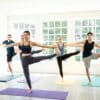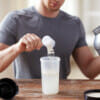The Balance Of Strength Between Your Upper And Lower Body
Have you ever questioned whether you’re doing strength training correctly? It’s common to wonder about the tiny details that can enhance your rows, bicep curls, and deadlifts, not to mention the plethora of fitness terminology thrown around (reps! sets! supersets!). As you work on training your entire body, you may start to notice that certain muscles seem more developed than others. For instance, your triceps might not be as strong as your glutes. If you’re curious as to why your lower body appears to be more powerful than your upper body, FitOn app trainer, Caroline Pearce, MSc, sheds some light on the matter.
“The most noticeable distinction between the upper and lower body is the size of the muscles, particularly the gluteal muscles in the lower body,” explains Pearce. “Typically, we engage our lower body more throughout the day with activities like walking, climbing stairs, and everyday movements such as sitting and standing—essentially squatting—frequently. On the other hand, our upper body bears less weight unless actively lifting objects, which occurs less frequently.” The rationale is simple: if we spent our days walking on our hands, our upper-body muscles would likely be more robust. However, since that’s not how we navigate our world, the glutes, quads, thighs, and calves emerge as the powerhouse muscles.
If you’re familiar with strength training, you’ve probably observed this strength imbalance, where you can lift substantially more weight with your lower body than your upper body. Pearce explains, “It’s quite normal to have a higher lifting capacity with the lower body compared to the upper body, unless you’ve specifically focused on heavy upper body training while neglecting the lower body.” As a general rule, she notes that you can typically lift double the weight with your lower body compared to your upper body. So, while you might be curling 15-pound dumbbells for your biceps, you could easily handle 30 pounds or more for exercises like sumo squats.
Now that you understand the unique dynamics of your upper and lower body strength, you’re equipped to train both areas effectively for optimal strength and mobility. Pearce outlines some basic steps to advance your full-body training while acknowledging the varying needs of your muscle groups.
1. Establish a base level of strength for your upper and lower body
“Start by attaining a foundational level of strength by performing higher reps—15 to 20 reps for three sets—with lighter weights to grasp the movement patterns and range of motion,” advises Pearce. Naturally, this initial level will differ for your upper and lower body muscles.
2. Apply progression
Pearce suggests two methods of progression. First, you can increase the number of reps (eight to 12) and sets (three to five) with adequate rest periods of two to three minutes in between. Secondly, you can introduce variety by changing up your exercises, which will challenge your muscles to adapt. Pearce explains, “Switching equipment, like using dumbbells, cables, or barbells, can provide different stimuli for your muscles.”
3. Superset
“Pairing the main exercise with an opposing muscle movement—for instance, triceps kickback paired with biceps curl—can further push your muscles to grow stronger,” says Pearce. “This approach enables you to gradually increase the weight you can lift.”
4. Be consistent
Ensure that you distribute your attention evenly between your upper and lower body. Pearce advises, “In a total body workout, incorporate exercises for both your arms and legs or opt for compound exercises like burpees or squat to overhead press. If you prefer splitting your training by body parts on different days, make sure to balance every ‘leg day’ with an ‘arm day’ and so on.”
















